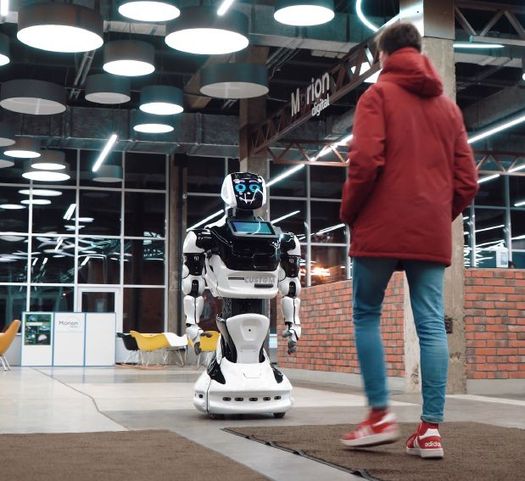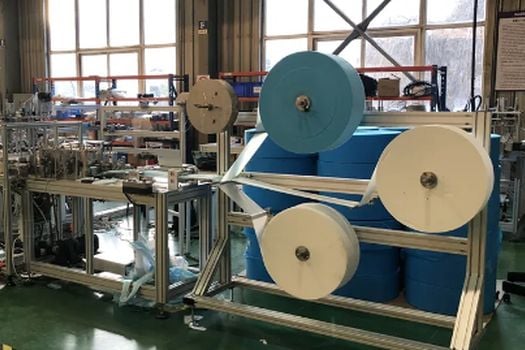
Robots are playing an important role in combatting the coronavirus. We look at some of the ways in which robots are keeping people safe, fed, and able to access the care they need through the pandemic.
With many countries in full or partial lockdown to halt the progression of the coronavirus, robots are stepping in to perform vital tasks that keep people safe and enable virtual contact. Many robot suppliers are donating or lending robots to hospitals and care homes to help stem the spread of the virus.
Here are some of the ways robots are being put to work:
Cleaning and disinfection
Robots are used in hospitals to disinfect rooms using ultraviolet rays that also kill the coronavirus. Ultra-violet disinfection robots can destroy 99.99% of all microorganisms in a hospital room within 10 minutes. While the room must be empty during disinfection, there are no negative effects of the UV rays. The robot’s route can be planned by hospital staff through an app and, once activated, cleaning robots move autonomously from room to room. On arrival, the robot makes an announcement asking anyone in the room to leave and close the door at which point cleaning can begin. Many of these robots can also operate lifts.
Many hospitals already use these robots to combat infections caught during hospital stays, which account for around 37,000 deaths per year in Europe and almost 100,000 in the U.S. However, suppliers of cleaning robots have experienced a surge in demand due to the spread of the coronavirus.
In Hong Kong, cleaning robots are now being used to clean carriages in the city’s Mass Transit Railway, which transports millions of passengers every day. The newly designed robot supplements the work of cleaning staff by spraying a hydrogen peroxide solution on to surfaces, focusing particularly on small gaps that human hands cannot reach.
Keeping doctors and nurses safe and support lab staff
Robots are being used to treat patients with the coronavirus, enabling doctors and nurses to carry out tests and interact with patients at arms length. The first US patient diagnosed with the virus was treated by a remotely-controlled robot equipped with a stethoscope and a screen that enabled doctors and nurses to communicate with the patient and take simple measurements.
Robots, from suppliers such as KUKA and Universal Robots, are used extensively to automate the lab work, e.g. the processing of samples, vastly improving the productivity of testing for bacterial and viral infections. Also Yaskawa and ABB are collaborating with hospital and medical labs to develop applications where their two-armed robot support the staff and speeding up testing.
Now, a robot that automates the process of taking mouth swabs, in order to test for the virus, is in clinical trials in China. The aim is to reduce infection risk to medical staff by eliminating the need for contact. Developed by Shenyang Institute of Automation, Chinese Academy of Sciences, the robot can sense contact and pressure and is able to gently take a sample that is then sent for analysis, with no human interaction required.
Helping older people stay in touch with carers and families
Many countries are advising or mandating that older people stay at home and refrain from contact with any family members not already living with them. This creates a dilemma for carers in residential homes for older people. Telepresence robots, already used in many assisted-living homes to enable older people to live independently for longer, are stepping in to keep elderly people in touch with carers and family. The image of the remote user is displayed on the robot’s screen and the robot can be directed around the room to view anything in its vicinity. Most of these robots are controllable from any location with a smartphone or computer and internet connection. Family members, friends, doctors, and care givers can all log into the telepresence robot, drive it, interact with others, and explore the environment with audio and video.
Delivering food and medical supplies
Robots are used in a wide variety of sectors for delivering parts, supplies and food. Delivery robots – such as those from IFR members MIR and Photoneo - are already used extensively in hospitals to deliver medical supplies and heavy items such as bedding throughout hospitals, saving nurses and orderlies many hours of time. Typically, these robots deliver items to nurse stations, but they are now being used to make deliveries directly to patients in isolation both in hospitals, and in other locations. For example, robots delivered food to people who had been on a flight with passengers infected with the virus and subsequently ordered into quarantine in a hotel in Hangzhou, China. The robot announces its arrival at the door and the occupant takes their food tray off the robot’s inbuilt shelf.
Delivery robots are also being used to bring groceries and pre-prepared meals to people, and to dispense hand sanitizer in public places.
Food preparation
Robots are starting to be used in food preparation, making pizza and in-store bread, for example. Now they have been enlisted in the effort to stem the spread of the coronavirus. Robots have been used in China to prepare and serve food to medical workers so that hospital canteens do not need to be staffed round the clock. A food preparation robot delivered to a hospital in Wuhan, China, reportedly prepared 36 portions of rice casserole every 15 minutes.
Public Information
Mobile information robots are increasingly used in public spaces, for example airports and trade fairs, and in shops, to help people get to their destination and find goods more easily. Information robots are also playing their part in keeping people safe by keeping them informed and reminded of safety precautions related to the virus. A robot, supplied by Russian manufacturer Promobot, was recently rolled out in various locations in New York City to converse with passersby, who could also fill out an online questionnaire on the robot’s touchscreen. The robot can also be equipped with a thermo reader to detect early symptoms of covid-19 like elevated temperature.

Meanwhile in China, UBTECH robots have been used at a hospital in Shenzhen for temperature monitoring of patients and visitors outside and inside the hospital and distribution of hand sanitizer, as well as providing information about the virus to arriving visitors.
Flexible Manufacturing – Producing Medical Equipment and Auxiliaries
In the current situation, we also well benefit from robots as flexible manufacturing tools that can quickly be reprogrammed to service changing needs.
Robots are for example being drafted in to speed up the production of medical equipment such as surgical masks that are in short supply. Chinese robot manufacturer SIASUN has set up over 100 robotic production lines for face masks, for example.

Also assembly equipment manufacturer PIA Automation helps to respond to the sharp increase in demand for face masks and other personal protective equipment (PPE). The assembly equipment manufacturer offers fully automated assembly lines for the high-speed production of protective masks. Orders for 21 of these mask production lines have already been received. Each line can produce 140,000 pieces per day and even cover several product variants of two-, three- or four-layer disposable masks. The manufacturing process includes feeding of filter material, folding and pressing, feeding of nose bridge clips, forming of the masks, cutting of the masks, welding of the ear straps, packaging and other auxiliary processes. In order to meet the increased global demand, the machines are built in plants in China, Germany and the USA, which are distributed all over the world.
Keeping businesses afloat
Small-to-medium sized companies in a range of industries - from manufacturing to logistics, food processing, retail and healthcare – are investing in collaborative industrial robots that can support workers by completing fetching-and-carrying, heavy lifting, machine feeding, shelf-filling and other monotonous tasks. Employees are able to focus on higher-value tasks, from spending time with patients and interacting with customers, to overseeing multiple small-batch production runs. These robots are particularly useful for companies with variable demand for human resources, either because demand is seasonal, such as in retail and agriculture, or because orders are unpredictable as can be the case in manufacturing. These robots are ideal in times of short-term labour shortages, such as the current coronavirus, as they can be easily programmed to take over tasks of missing employees, and then shift back to other duties once those employees return to work.
Examples on YouTube
Robots used in a Chinese hospital for disinfection, delivery, and monitoring the temperature of arrivals. Source: South China Morning Post
Telepresence robots enable carers and family to keep in touch with elderly people Source: Telepresence Robots
A robot delivers food in a Chinese hospital. Source: New China News
Delivery robots bring food and pre-prepared meals, and dispense hand-sanitizer. Source: CGTN
The robot chef at a Wuhan hospital. Source: The Paper
IFR Secretariat
The General Secretariat is responsible for the daily management of IFR and the coordination of all major activities, events and collaboration. The General Secretariat handles all questions regarding IFR membership.

Dr. Susanne Bieller
IFR General Secretary
Phone: +49 69-6603-1502
E-Mail: secretariat(at)ifr.org

Silke Lampe
Communication Manager
Phone: +49 69-6603-1697
E-Mail: secretariat(at)ifr.org
Credits · Legal Disclaimer · Privacy Policy ·World Robotics Terms of Usage · © IFR 2025
